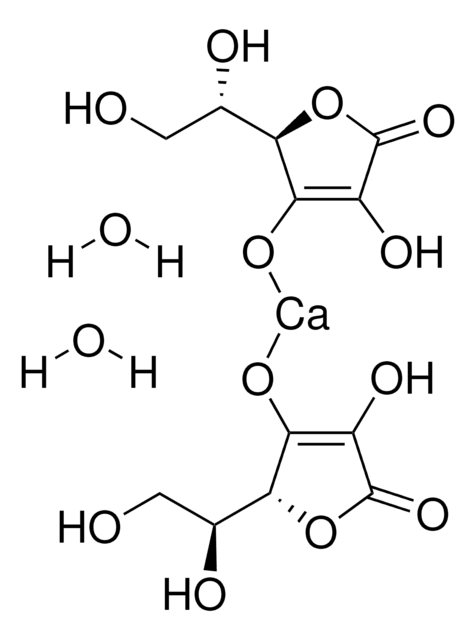A4034
(+)-Sodium L-ascorbate
powder, BioReagent, suitable for cell culture
Sinónimos:
L(+)-Ascorbic acid sodium salt, Vitamin C sodium salt
About This Item
Productos recomendados
origen biológico
synthetic (organic)
Nivel de calidad
Línea del producto
BioReagent
Análisis
≥98%
formulario
powder
mol peso
Mw 135.13 g/mol
técnicas
cell culture | mammalian: suitable
cell culture | plant: suitable
color
white to off-white
mp
220 °C (dec.) (lit.)
solubilidad
H2O: 50 mg/mL
cadena SMILES
[Na+].OC[C@H](O)[C@H]1OC(=O)C(O)=C1[O-]
InChI
1S/C6H8O6.Na/c7-1-2(8)5-3(9)4(10)6(11)12-5;/h2,5,7-10H,1H2;/q;+1/p-1/t2-,5+;/m0./s1
Clave InChI
PPASLZSBLFJQEF-RXSVEWSESA-M
¿Está buscando productos similares? Visita Guía de comparación de productos
Descripción general
Aplicación
- to produce H2O2 in cell culture media
- as a reducing agent for a cell-permeable artificial electron donor, N,N,N′,N′-tetramethyl-p-phenylenediamine (TMPD)
- to study its effect on production of collagen and elastic fibers in fibroblasts cultures derived from normal human skin and dermal fat
Acciones bioquímicas o fisiológicas
Código de clase de almacenamiento
11 - Combustible Solids
Clase de riesgo para el agua (WGK)
WGK 1
Equipo de protección personal
Eyeshields, Gloves, type N95 (US)
Certificados de análisis (COA)
Busque Certificados de análisis (COA) introduciendo el número de lote del producto. Los números de lote se encuentran en la etiqueta del producto después de las palabras «Lot» o «Batch»
¿Ya tiene este producto?
Encuentre la documentación para los productos que ha comprado recientemente en la Biblioteca de documentos.
Los clientes también vieron
Artículos
Importance and uses of ascorbate in serum-free eukaryotic, including hybridoma and Chinese Hamster Ovary (CHO) cell, cultures
Antioxidants protect biological systems from oxidative damage produced by oxygen-containing free radicals and from redoxactive transition metal ions such as iron, copper, and cadmium.
Nuestro equipo de científicos tiene experiencia en todas las áreas de investigación: Ciencias de la vida, Ciencia de los materiales, Síntesis química, Cromatografía, Analítica y muchas otras.
Póngase en contacto con el Servicio técnico








